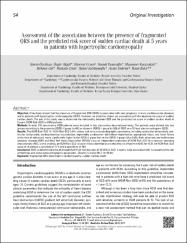| dc.contributor.author | Özyılmaz, Sinem Özbay | |
| dc.contributor.author | Akgül, Özgür | |
| dc.contributor.author | Uyarel, Hüseyin | |
| dc.contributor.author | Püşüroğlu, Hamdi | |
| dc.contributor.author | Karayakalı, Muammer | |
| dc.contributor.author | Gül, Mehmet | |
| dc.contributor.author | Çetin, Mustafa | |
| dc.contributor.author | Satılmışoğlu, Hulusi | |
| dc.contributor.author | Yıldırım, Aydın | |
| dc.contributor.author | Bakır, İhsan | |
| dc.date.accessioned | 2020-12-19T20:42:36Z | |
| dc.date.available | 2020-12-19T20:42:36Z | |
| dc.date.issued | 2017 | |
| dc.identifier.citation | Özyılmaz, S., Akgül, Ö. Uyarel, H. Püşüroğlu, H., Karayakalı, M. ve diğerleri. (2017). Assessment of the association between the presence of fragmented QRS and the predicted risk score of sudden cardiac death at 5 years in patients with hypertrophic cardiomyopathy. The Anatolian Journal of Cardiology, 18(1), 54-61. | en_US |
| dc.identifier.issn | 2149-2263 | |
| dc.identifier.issn | 2149-2271 | |
| dc.identifier.uri | https://app.trdizin.gov.tr/makale/TWpneU56TTNOdz09 | |
| dc.identifier.uri | https://hdl.handle.net/11436/5745 | |
| dc.description.abstract | Objective: It has been shown that the presence of fragmented QRS (fQRS) is associated with poor prognosis in many cardiovascular diseases and in patients with hypertrophic cardiomyopathy (HCM). However, no study has shown an association with the absolute risk score of sudden cardiac death. The aim of this study was to determine the relationship between QRS and the predicted risk score of sudden cardiac death at 5 years (HCM Risk-SCD) in HCM patients.Methods: In total, 115 consecutive HCM patients were included in this prospective observational study. The patients were divided into two groups according to the presence [fQRS(+) group (n=65)] or absence [fQRS(–) group (n=50)] of fQRS on a 12-lead electrocardiogram (ECG).Results: The HCM Risk-SCD (%) HCM Risk-SCD (>6%) values and some echocardiographic parameters, including ventricular extrasystole, ventricular tachycardia, cardiopulmonary resuscitation, implantable cardioverter defibrillator implantation, appropriate shock, and heart failure at the time of admission, were significantly higher in the fQRS(+) group than in the fQRS(–) group (all p<0.05). Both univariate and multivariate analyses revealed fQRS and New York Heart Association (NYHA) class as independent predictors of HCM Risk-SCD. In a receiver operating characteristic (ROC) curve analysis, an HCM Risk-SCD value of >4 was identified as an effective cut-off point in fQRS for HCM. An HCM Risk-SCD value of >4 yielded a sensitivity of 77% and a specificity of 76%.Conclusion: fQRS is determined to be an independent high-risk indicator of HCM Risk-SCD. It seems to be associated with increased ventricular arrhythmias and some echocardiographic parameters | en_US |
| dc.language.iso | eng | en_US |
| dc.publisher | Turkish Soc Cardiology | en_US |
| dc.rights | info:eu-repo/semantics/openAccess | en_US |
| dc.subject | Kalp ve Kalp Damar Sistemi | en_US |
| dc.subject | Parçalanmış QRS | en_US |
| dc.subject | Hipertrofik Kardiyomiyopati | en_US |
| dc.subject | Ani Kalp Ölümü | en_US |
| dc.title | Assessment of the association between the presence of fragmented QRS and the predicted risk score of sudden cardiac death at 5 years in patients with hypertrophic cardiomyopathy | en_US |
| dc.type | article | en_US |
| dc.contributor.department | RTEÜ, Tıp Fakültesi, Dahili Tıp Bilimleri Bölümü | en_US |
| dc.contributor.institutionauthor | Çetin, Mustafa | |
| dc.identifier.volume | 18 | en_US |
| dc.identifier.issue | 1 | en_US |
| dc.identifier.startpage | 54 | en_US |
| dc.identifier.endpage | 61 | en_US |
| dc.ri.edit | oa | en_US |
| dc.relation.journal | The Anatolian Journal of Cardiology | en_US |
| dc.relation.publicationcategory | Makale - Uluslararası Hakemli Dergi - Kurum Öğretim Elemanı | en_US |


















